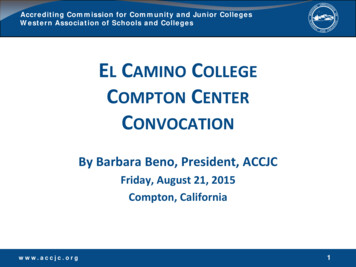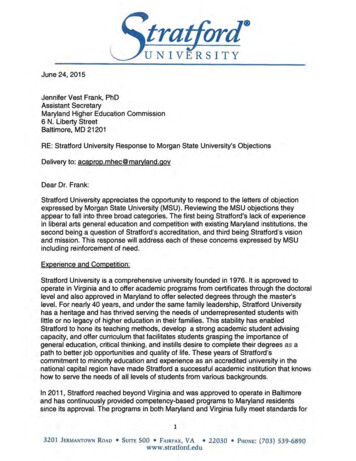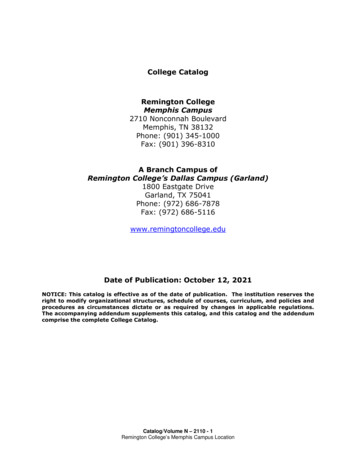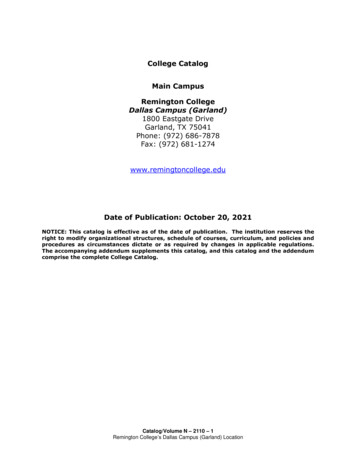
Transcription
Accrediting Commission for Community and Junior CollegesWestern Association of Schools and CollegesEL CAMINO COLLEGECOMPTON CENTERCONVOCATIONBy Barbara Beno, President, ACCJCFriday, August 21, 2015Compton, Californiawww.accjc.org1
Accrediting Commission for Community and Junior CollegesWestern Association of Schools and CollegesTHE 2014 ACCREDITATION STANDARDS: A FOCUS ONQUALITY AND IMPROVEMENTQuality is defined as institutional characteristicsand processes that support and improve studentlearning and student achievement so thatinstitutional mission is achievedwww.accjc.org2
Accrediting Commission for Community and Junior CollegesWestern Association of Schools and CollegesWHY DO WE CARE ABOUTACCREDITATION? Fundamentally, we care about students and learning,and accreditation focuses an institution on thoseelements of institutional operationsAccreditation holds us to high standards for our workand our institution’s outcomesSuccessful accreditation review validates the hard workwe do to educate studentswww.accjc.org3
Accrediting Commission for Community and Junior CollegesWestern Association of Schools and CollegesPURPOSES OF ACCREDITATION Provide quality assurance to the public andstudents, as well as to federal and stategovernmentsProvide impetus for institutional improvementand support for educational excellenceHelp higher education become more effectivewww.accjc.org4
Accrediting Commission for Community and Junior CollegesWestern Association of Schools and CollegesORGANIZATION OF ACCREDITATION Institutions formed membership organizations,accrediting agencies, as membership entities, withrequirements of “members”Accreditors that evaluated the whole institutionformed membership entities in geographic regions –hence, Western Association, Southern Association, etc.Accreditation is non-governmental, peer reviewAccreditation is voluntary-institutions voluntarilysubmit to requirements, evaluators are volunteerswww.accjc.org5
Accrediting Commission for Community and Junior CollegesWestern Association of Schools and CollegesMOST IMPORTANT ASPECTS OF QA Accreditors apply standards and evaluations honestlyand carefully to each institution in the context of itsmissionInstitutions have in place their own ongoing QAsystems and use them to self assess, and to maintainand improve qualityInstitutions use the feedback from evaluation teamsand the Commission to make improvements, to meetstandards and to excel in producing educated studentswww.accjc.org6
Accrediting Commission for Community and Junior CollegesWestern Association of Schools and CollegesACCREDITATION STANDARDS Standard I: Mission, Institutional Effectiveness andIntegrity (new)Standard II: Educational Programs – Instruction, Libraryand Learning Services, and Student Support ServicesStandard III: Institutional Resources – HumanResources, Physical Resources, Technology andFinancial ResourcesStandard IV: Leadership and Decision Making, andGovernancewww.accjc.org7
Accrediting Commission for Community and Junior CollegesWestern Association of Schools and CollegesSUMMARY OFCHANGES TO THE STANDARDSSimplified formatReduced redundancies and clarified languageLinked with Eligibility RequirementsNew emphasis on results (Student Achievement)Improvement throughout the institutionNew Section in Standard I on Institutional Integrity (I.C)www.accjc.org8
Accrediting Commission for Community and Junior CollegesWestern Association of Schools and Colleges NEW PRACTICESSeven-Year Cycle with Midterm in year 4Quality Focus EssayActionable Improvements Plans (coming fromthe institution’s comprehensive self evaluation).should be incorporated into existing institutionalplanning processes; Improvements made shouldbe noted;Continuedwww.accjc.org9
Accrediting Commission for Community and Junior CollegesWestern Association of Schools and CollegesNEW PRACTICES – 2 New Midterm Report format Analysis of data trends from Annual Reportsand Annual Fiscal Reports Improvement recommendations Status of 2-3 significant quality improvementprojects described in Quality Focus EssayContinuedwww.accjc.org10
Accrediting Commission for Community and Junior CollegesWestern Association of Schools and CollegesNEW PRACTICES – 3 Individual College Monitoring and Follow-Up ofData Indicators in Annual Reports ACCJC provides the templates in the AnnualReport which carry over to the Midterm Institution is asked to describe any additionalinstitution-set standards (data elements) Practice is required by USDEwww.accjc.org11
Accrediting Commission for Community and Junior CollegesWestern Association of Schools and CollegesNEW PRACTICES – 4 Compliance vs Improvementrecommendations Separated in action letters Standards are either met or not met (no“partial” compliance) Non-compliance must be addressed beforethe Midterm Report; improvement effortswill continue throughout the 7-year cyclewww.accjc.org12
Accrediting Commission for Community and Junior CollegesWestern Association of Schools and CollegesCHANGES TO POLICY Policy on Commission Actions on Institutions Reaffirmation for one year (new option) Requirement of compliance within two years(federal two-year rule) Changed timeline for Commission follow-up(generally 18 months) Common definitions for sanctions across allall regional accreditorswww.accjc.org13
Accrediting Commission for Community and Junior CollegesWestern Association of Schools and CollegesCHANGES TO TRAININGS Spring 2015 Symposium ACCJC Annual Conference (October 2016) Conference session on Developing a SelfEvaluation Report one year beforeevaluation visitConference sharing session on “WhatHappens After the Evaluation Visit”www.accjc.org14
Accrediting Commission for Community and Junior CollegesWestern Association of Schools and CollegesSTANDARD I: MISSION, ACADEMICQUALITY AND INSTITUTIONALEFFECTIVENESS, AND INTEGRITYwww.accjc.org15
Accrediting Commission for Community and Junior CollegesWestern Association of Schools and Colleges1: QUALITY The word “quality” appears 9 times in StandardI, in the title of the standard, the title of I.B, andin I.B.1, I.B.7, I.B.9, I.C.3, I.C.14 “temperament, character, disposition," from OldFrench qualite "quality, nature, characteristic” What quality is your college known for? What local processes have led to improvementsin institutional quality?www.accjc.org16
Accrediting Commission for Community and Junior CollegesWestern Association of Schools and Colleges2: MISSION The word “mission” appears 8 times in StandardI, in chapter and heading titles and in I.B.3, I.B.5,I.B.7, I.B.9, I.C.1, & I.C.5 If mission drives planning, can a college’smission be defined so broadly that it provides noguidance in planning? How are parts of missiondefined so they can be assessed?www.accjc.org17
Accrediting Commission for Community and Junior CollegesWestern Association of Schools and Colleges3: DATA (PL.) The word “data” appears 5 times, in theStandard I Introduction and I.A.2, I.B.4, I.B.5 &I.C.9 “Using analysis of quantitative and qualitativedata, the institution continuously andsystematically evaluates ” II.A.2): therelationship of quantitative & qualitative datawww.accjc.org18
Accrediting Commission for Community and Junior CollegesWestern Association of Schools and Colleges4: INSTITUTION SET STANDARDS “The institution establishes institution-setstandards ” Colleges were notified in January 2013 of newFederal requirement (the ACCJC did not inventthis new requirement) Standards must be set for institutional studentachievement (e.g., completion, job placement,transfer) and for programs, including CTEwww.accjc.org19
Accrediting Commission for Community and Junior CollegesWestern Association of Schools and Colleges5: DISAGGREGATES “The institution disaggregates and analyzeslearning outcomes and achievement forsubpopulations of students. When theinstitution identifies performance gaps, itimplements strategies ” I.B.6 An institution selects which subpopulations arecritical to examine in order to understandwhether it is achieving its missionwww.accjc.org20
Accrediting Commission for Community and Junior CollegesWestern Association of Schools and Colleges6: “BROADLY COMMUNICATES” “The institution broadly communicates theresults of all of its assessment and evaluationactivities ” Assessment data is provided to the public What amount of data would be too little? What amount of data would be too much?www.accjc.org21
Accrediting Commission for Community and Junior CollegesWestern Association of Schools and CollegesSTANDARD II: STUDENT LEARNINGPROGRAMS AND SUPPORT SERVICESwww.accjc.org22
Accrediting Commission for Community and Junior CollegesWestern Association of Schools and CollegesSTANDARD II: STUDENT LEARNINGPROGRAMS AND SUPPORT SERVICESII.A – Instructional ProgramsII.B – Library and Learning Support ServicesII.C – Student Support Serviceswww.accjc.org23
Accrediting Commission for Community and Junior CollegesWestern Association of Schools and CollegesII.A. INSTRUCTIONAL PROGRAMSwww.accjc.org24
II.A – INSTRUCTIONAL PROGRAMSAccrediting Commission for Community and Junior CollegesWestern Association of Schools and CollegesII.A.1: All instructional programs, regardless of location ormeans of delivery, including distance education andcorrespondence education are offered in fields of studyconsistent with the institution’s mission, are appropriateto higher education, and culminate in student attainmentof identified student learning outcomes and achievementof degrees, certificates, employment, or transfer. (ACCJCEligibility Requirement ER 9 and ER 11)oNew emphasis on student attainment and achievement, ratherthan SLOs existing and programs qualifying for degrees,certifications, employment or transfer.www.accjc.org25
Accrediting Commission for Community and Junior CollegesWestern Association of Schools and CollegesII.A.2. Faculty, including full-time, part-time, and adjunctfaculty ensure that the content and methods ofinstruction meet generally accepted academic andprofessional standards and expectations. Faculty andothers responsible act to continuously improveinstructional courses, programs and directly relatedservices through systematic evaluation to assurecurrency, improve teaching and learning strategies, andpromote student success.ooNew emphasis identifies the actors instead of generallystating “the institution”New emphasis on continuous improvement (rather thanepisodic activities)www.accjc.org26
Accrediting Commission for Community and Junior CollegesWestern Association of Schools and CollegesII.A.4. If the institution offers pre-collegiate levelcurriculum, it distinguishes that curriculum fromcollege level curriculum and directly supports studentsin learning the knowledge and skills necessary toadvance to and succeed in college level curriculum.o Pulls out pre-collegiate curriculum for emphasiso Expresses the expectation that pre-collegiate curriculum isdistinguished from the college level curriculumo Identifies the need for pre-collegiate curriculum to supportstudent advancement to college level curriculum.www.accjc.org27
Accrediting Commission for Community and Junior CollegesWestern Association of Schools and CollegesII.A.5. The institution’s degrees and programs follow practicescommon to American higher education, including appropriatelength, breadth, depth, rigor, course sequencing, time tocompletion, and synthesis of learning. The institution ensuresthat minimum degree requirements are 60 semester creditsor equivalent at the associate level, and 120 credits orequivalent at the baccalaureate level. (ER 12)ooAll of the Accreditation Standards apply to baccalaureatedegrees, but there are some specific references in the 2014standardsThe ACCJC is recognized by the U.S. Department of Education forapproving a baccalaureate degree at a member institutionthrough substantive change. Substantive change criteria giveadditional information to institutions about the review of aproposed BA.www.accjc.org28
Accrediting Commission for Community and Junior CollegesWestern Association of Schools and Colleges6. The institution schedules courses in a manner thatallows students to complete certificate and degreeprograms within a period of time consistent withestablished expectations in higher education. (ER 9)oNew standardwww.accjc.org29
Accrediting Commission for Community and Junior CollegesWestern Association of Schools and CollegesII.A.9. The institution awards course credit, degreesand certificates based on student attainment oflearning outcomes. Units of credit awarded areconsistent with institutional policies that reflectgenerally accepted norms or equivalencies in highereducation. If the institution offers courses based onclock hours, it follows Federal standards for clock-tocredit-hour conversions. (ER 10)o This requirement, which has existed previously inpolicy, and in federal regulations, has now been addedto the standards.www.accjc.org30
Accrediting Commission for Community and Junior CollegesWestern Association of Schools and CollegesII.A.11. The institution includes in all of its programs,student learning outcomes, appropriate to theprogram level, in communication competency,information competency, quantitative competency,analytic inquiry skills, ethical reasoning, the ability toengage diverse perspectives, and other programspecific learning outcomes.o This standard discusses learning outcomes that are forstudents at the institution in programs of any type orlength.o Of note is the phrase “appropriate to the programlevel.” These will look very different in a short termprogram versus an AA or BA degree.o For many institutions, these outcomes are contained inidentified institutional learning outcomes (ILOs).www.accjc.org31
Accrediting Commission for Community and Junior CollegesWestern Association of Schools and CollegesII.A.12. The institution requires of all of its degree programs acomponent of general education based on a carefully consideredphilosophy for both associate and baccalaureate degrees that isclearly stated in its catalog. The institution, relying on facultyexpertise, determines the appropriateness of each course forinclusion in the general education curriculum, based uponstudent learning outcomes and competencies appropriate tothe degree level. The learning outcomes include a student’spreparation for and acceptance of responsible participation incivil society, skills for lifelong learning and application of learningand a broad comprehension of the development of knowledge,practice, and interpretive approaches in the arts and humanities,the sciences, mathematics, and social sciences.www.accjc.org32
Accrediting Commission for Community and Junior CollegesWestern Association of Schools and CollegesII.A.13. All degree programs include a focused study in at leastone area of inquiry or in an established interdisciplinary core.The identification of specialized courses in an area of inquiryor interdisciplinary core is based upon student learningoutcomes and competencies, and include mastery, at theappropriate degree level, of key theories and practices withinthe field of study.ooStudent learning outcomes at the degree level representhigher order learning and competencies than do theoutcomes in shorter length programs.The concept of mastery, appropriate to the degree level, isabout depth of learning in key areas related to the degreediscipline. as well as attaining the skills for mastery ofparticular practices and knowledge.www.accjc.org33
Accrediting Commission for Community and Junior CollegesWestern Association of Schools and CollegesII.A.14. Graduates completing career-technicalcertificates and degrees demonstrate technical andprofessional competencies that meet employmentstandards and other applicable standards andpreparation for external licensure and certification.oCTE programs are charged with ensuring their studentsdemonstrate certain technical and professionalcompetencies, either within or in addition to the SLOsdiscussed in Standards II.A.11,12 and 13.www.accjc.org34
Accrediting Commission for Community and Junior CollegesWestern Association of Schools and CollegesII.A.16. The institution regularly evaluates andimproves the quality and currency of all instructionalprograms offered in the name of the institution,including collegiate, pre-collegiate, career-technical,and continuing and community education courses andprograms regardless of delivery mode or location. Theinstitution systematically strives to improve programsand courses to enhance learning outcomes andachievement of students.ooNot new, but notice the specific reference to continuingand community education courses.The assessment and evaluation in some types of courses orprograms may look different from that used for mostinstructional programs.www.accjc.org35
Accrediting Commission for Community and Junior CollegesWestern Association of Schools and CollegesII.B. LIBRARY ANDLEARNING SUPPORT SERVICESwww.accjc.org36
Accrediting Commission for Community and Junior CollegesWestern Association of Schools and Colleges1.The institution supports student learning andachievement by providing library, and other learningsupport services to students and to personnelresponsible student learning and support. Theseservices are sufficient in quantity, currency, depth,and variety to support educational programs,regardless of location or means of delivery,including distance education and correspondenceeducation. Learning support services include, butare not limited to, library collections, tutoringlearning centers, computer laboratories, learningtechnology, and ongoing instruction for uses oflibrary and other learning support services. (ER 17)www.accjc.org37
Accrediting Commission for Community and Junior CollegesWestern Association of Schools and CollegesII.B.4. When the institution relies on or collaborateswith other institutions or other sources for library andother learning support services for its instructionalprograms, it documents that formal agreements existand that such resources and services are adequate forthe institution’s intended purposes, are easilyaccessible and utilized. The institution takesresponsibility for and assures the security,maintenance, and reliability of services providedeither directly or through contractual arrangement.The institution regularly evaluates these services toensure their effectiveness. (ER 17)www.accjc.org38
Accrediting Commission for Community and Junior CollegesWestern Association of Schools and CollegesII.C. STUDENT SUPPORT SERVICESwww.accjc.org39
Accrediting Commission for Community and Junior CollegesWestern Association of Schools and CollegesII.C.2. The institution identifies and assesses learningsupport outcomes for its student population andprovides appropriate student support services andprograms to achieve those outcomes. The institutionuses assessment data to continuously improvestudent support programs and services.www.accjc.org40
Accrediting Commission for Community and Junior CollegesWestern Association of Schools and CollegesII.C.3. The institution assures equitable access to all ofits students by providing appropriate, comprehensive,and reliable services to students regardless of servicelocation or delivery method. (ER 15)www.accjc.org41
Accrediting Commission for Community and Junior CollegesWestern Association of Schools and CollegesII.C.4. Co-curricular programs and athletic programs aresuited to the institution's mission and contribute to thesocial and cultural dimensions of the educationalexperience of its students. If the institution offers cocurricular or athletic programs, they are conducted withsound educational policy and standards of integrity. Theinstitution has responsibility for the control of theseprograms, including their finances.ooA new standard.Note the linkage of co-curricular programs and athletics programs tothe institution’s mission.www.accjc.org42
Accrediting Commission for Community and Junior CollegesWestern Association of Schools and CollegesII.C.5. The institution provides counseling and/oracademic advising programs to support studentdevelopment and success and prepares faculty andother personnel responsible for the advising function.Counseling and advising programs orient students toensure they understand the requirements related totheir programs of study and receive timely, useful,and accurate information about relevant academicrequirements, including graduation and transferpolicies.www.accjc.org43
Accrediting Commission for Community and Junior CollegesWestern Association of Schools and CollegesII.C.6. The institution has adopted and adheres toadmission policies consistent with its mission thatspecify the qualifications of students appropriate for itsprograms. The institution defines and advises studentson clear pathways to complete degrees, certificates,and transfer goals.ooThis is a new standard.Be sure to include baccalaureate degrees, if offered.www.accjc.org44
Accrediting Commission for Community and Junior CollegesWestern Association of Schools and CollegesSTANDARD III: RESOURCESwww.accjc.org
Accrediting Commission for Community and Junior CollegesWestern Association of Schools and CollegesSTANDARD IIITHEMES OF CHANGES Improve clarity Improve planning Recognize role and importance of part time andadjunct faulty in processes Expand recognition of comprehensive nature ofplanning considerations (TCO) Reorganize and restructure (especially III.D)www.accjc.org46
Accrediting Commission for Community and Junior CollegesWestern Association of Schools and CollegesIII.A: HUMAN RESOURCES III.A.5:The institution assures the effectivenessof its human resources by evaluating allpersonnel systematically and at statedintervals. . Evaluation processes seek toassess effectiveness of personnel and encourageimprovement. Actions taken followingevaluations are formal, timely, anddocumented.www.accjc.org47
Accrediting Commission for Community and Junior CollegesWestern Association of Schools and Colleges III.A.6 (formerly III.A.1.c):The evaluation of faculty,academic administrators, and other personnel directlyresponsible for student learning includes, as acomponent of that evaluation, consideration of howthese employees use the results of the assessment oflearning outcomes to improve teaching and learning.[reworded for clarity]www.accjc.org48
Accrediting Commission for Community and Junior CollegesWestern Association of Schools and CollegesIII.B: PHYSICAL RESOURCES III.B.1: The institution assures safe and sufficient physical resources at all locations where it offers courses,programs, and learning support services.III.B.2: The institution plans, acquires or builds,maintains, and upgrades or replaces its physical resources,including facilities, equipment, land, and other assets, in amanner that assures effective utilization and thecontinuing quality necessary to support its programs andservices and achieve its mission. [regardless of manner inwhich physical assets are acquired by institution.]www.accjc.org49
Accrediting Commission for Community and Junior CollegesWestern Association of Schools and Colleges III.B.4:Long-range capital plans supportinstitutional improvement goals and reflectprojections of the total cost of ownership of newfacilities and equipment. [What are thecomponents of TCO? Includes technology noted inIII.C.]www.accjc.org50
Accrediting Commission for Community and Junior CollegesWestern Association of Schools and CollegesIII.C: TECHNOLOGY RESOURCES III.C.1: Technology services, professional support, facilities, hardware, and software are appropriate andadequate to support the institution’s management andoperational functions, academic programs, teachingand learning, and support services.III.C.2: The institution continuously plans for, updatesand replaces technology to ensure its technologicalinfrastructure, quality and capacity are adequate tosupport its mission, operations, programs, and services.www.accjc.org51
Accrediting Commission for Community and Junior CollegesWestern Association of Schools and Colleges III.C.3: The institution assures that technology resourcesat all locations where it offers courses, programs, andservices are implemented and maintained to assurereliable access, safety, and security.III.C.4: The institution provides appropriate instructionand support for faculty, staff, students, andadministrators, in the effective use of technology andtechnology systems related to its programs, services, andinstitutional operations.III.C.5: The institution has policies and procedures thatguide the appropriate use of technology in the teachingand learning processes.www.accjc.org52
Accrediting Commission for Community and Junior CollegesWestern Association of Schools and CollegesIII.D: FINANCIAL RESOURCES III.D.1: . The institution plans and manages its financial affairs with integrity and in a manner that ensuresfinancial stability. (ER 18)III.D.2: The institution’s mission and goals are thefoundation for financial planning, and financial planning isintegrated with and supports all institutional planning. .III.D.4: Institutional planning reflects a realisticassessment of financial resource availability, developmentof financial resources, partnerships, and expenditurerequirements.www.accjc.org53
Accrediting Commission for Community and Junior CollegesWestern Association of Schools and Colleges III.D.9: The institution has sufficient cash flow and reserves to maintain stability, support strategies forappropriate risk management, and, when necessary,implement contingency plans to meet financialemergencies and unforeseen occurrences.III.D.11: The level of financial resources provides areasonable expectation of both short-term and long-termfinancial solvency. When making short-range financialplans, the institution considers its long-range financialpriorities to assure financial stability. The institution clearlyidentifies, plans, and allocates resources for payment ofliabilities and future obligations.www.accjc.org54
Accrediting Commission for Community and Junior CollegesWestern Association of Schools and Colleges III.D.12: The institution plans for and allocates appropriate resources for the payment of liabilities and futureobligations, including Other Post-Employment Benefits(OPEB), compensated absences, and other employeerelated obligations. The actuarial plan to determine OtherPost-Employment Benefits (OPEB) is current and preparedas required by appropriate accounting standards.III.D.15: The institution monitors and manages studentloan default rates, revenue streams, and assets to ensurecompliance with federal requirements, including Title IV ofthe Higher Education Act, and comes into compliance whenthe federal government identifies deficiencies.www.accjc.org55
Accrediting Commission for Community and Junior CollegesWestern Association of Schools and CollegesSTANDARD IV:LEADERSHIP AND GOVERNANCEwww.accjc.org
Accrediting Commission for Community and Junior CollegesWestern Association of Schools and CollegesIV.A: DECISION MAKING ROLESAND PROCESSES IV.A.1:Leaders create and encourageinnovation leading to excellence. IV.A.4: Faculty and academic administrators,through policy and procedures, and throughwell-defined structures, have responsibility forrecommendations about curriculum andstudent learning programs and services.www.accjc.org57
Accrediting Commission for Community and Junior CollegesWestern Association of Schools and Colleges IV.A.6 (NEW): The processes for decision-makingand the resulting decisions are documented andwidely communicated across the institution.IV.A.7: Leadership roles and the institution’sgovernance and decision-making policies,procedures, and processes are regularly evaluatedto assure their integrity and effectiveness. Theinstitution widely communicates the results of theseevaluations and uses them as the basis forimprovement.www.accjc.org58
Accrediting Commission for Community and Junior CollegesWestern Association of Schools and CollegesIV.B: CHIEF EXECUTIVE OFFICER IV.B.1: The institutional chief executive officer (CEO)has primary responsibility for the quality of theinstitution.IV.B.3: Through established policies and procedures,the CEO guides institutional improvement of theteaching and learning environment by: Ensuring college sets Institutional Performance Standards Integrating Institutional educational planning with resourceplanning and allocations Evaluating institutional planning and implementationwww.accjc.org59
Accrediting Commission for Community and Junior CollegesWestern Association of Schools and Colleges IV.B.4:(NEW)The CEO has the primary leadershiprole for accreditation, ensuring that the institutionmeets or exceeds Eligibility Requirements,Accreditation Standards, and Commission policiesat all times. Faculty, staff, and administrativeleaders of the institution also have responsibilityfor assuring compliance with accreditationrequirements.www.accjc.org60
Accrediting Commission for Community and Junior CollegesWestern Association of Schools and CollegesIV.C: GOVERNING BOARD IV.C.1: The institution has a governing board thathas authority over and responsibility for policies toassure the academic quality, integrity, andeffectiveness of the student learning programs andservices and the financial stability of the institution.(ER 7)IV.C.2: The governing board acts as a collectiveentity. Once the board reaches a decision, all boardmembers act in support of the decision.www.accjc.org61
Accrediting Commission for Community and Junior CollegesWestern Association of Schools and Colleges IV.B.8: To ensure the institution is accomplishing itsgoals for
Western Association of Schools and Colleges www.accjc.org EL CAMINO COLLEGE COMPTON CENTER CONVOCATION By Barbara Beno, President, ACCJC Friday, August 21, 2015 . Compton, California . 1 . Accrediting Commission for Community and Junior Colleges Western Association of Schools and Colleges www.accjc.org T HE 2014 A CCREDITATION S TANDARDS











